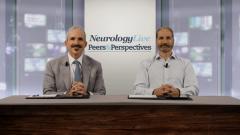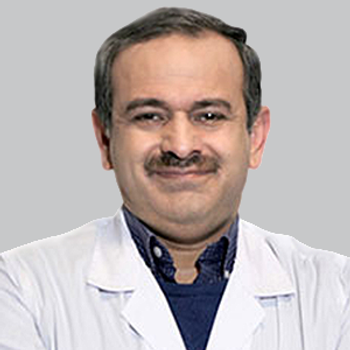
Considerations for Comprehensive Patient Evaluation and Switching to High-efficacy Therapies (HETs)
The MS experts share strategies to evaluate physical and cognitive disability progression and determine therapy changes in the clinical setting.
Episodes in this series

Bruce Hughes, MD: Do you have any advice for health care providers who manage patients with multiple sclerosis [MS], how they can identify PIRA [progression independent of relapse activity] and if they’re using lower-efficacy disease-modifying agents when it’s time to consider switching to a high-efficacy therapy?
Robert Naismith, MD: Yes. Every time my patients come in for a visit, I’m always going to ask them, “How do you feel like you’re doing compared to your last visit? Do you feel like you’re the same, better, or worse?” This is a chance to see where they’re at, and if they’re feeling like they’re doing worse, then that’s something that you need to dive into. [This is] particularly [important] for [patients] on lower-efficacy therapies because one of the big shifts that we’ve seen through the years is the earlier adoption of high-efficacy therapies. When anyone is showing any signs of worsening within any domain—whether it’s walking and balance, cognition, upper extremity function, [or] fatigue—if patients feel like they’re doing worse, then we’re going to have a much lower threshold to try to head that off by…escalating them to a high-efficacy therapy. So I think the first thing is just to find out from the patient, “How do you feel compared to the last visit?” but then also diving deeper into the different MS domains. So with every visit we discuss their gait, their strength in their arms, coordination, fatigue, cognition, sleep, and mood, and we go through the whole list of things that can happen with MS so that we’re sure to cover all the different things. And if you’re finding that patients are able to do less or they’re starting to restrict what they’re doing in their lives as a result, then that’s a big warning sign that they may be undertreated. So if patients feel like they’re not doing as well, and you’re seeing that over a couple visits, in particular that may be a sign that it’s time to escalate therapy. Sometimes these patients’ MRIs haven’t really changed. There [aren’t any] new lesions, they look like they’re doing pretty good, but they’re still pretty early in their MS, they’re still quite young, and they feel like they’re not able to do as much. Sometimes they may even ascribe it to other things. “Well, I’m just tired because the kids wear me out” or “I’m working, and this is just normal.” But it’s up to us to say, “Well, that’s not quite normal. I mean, you should have energy to do stuff on the weekends. And you should be able to go out for a walk for several miles without a problem at this point.” So sometimes patients write it off, and you have to ask them, “Well, what are you doing after work, or on the weekends, or in the yard, or at your home?” And then you find out [that] they’ve really changed what they’re doing as a result but haven’t really said that that’s due to the MS; they just ascribe it to other things that are going on in their lives. What types of things do you see in your practice?
Bruce Hughes, MD: I would say the same. I think we did pay attention a lot earlier to physical disability progression, but not really [to] cognitive disability progression. This has gained a lot more attention recently, and I think that [is] maybe driven by PIRA, but we used to think that the cognitive issues of multiple sclerosis were a later manifestation and not an earlier manifestation. But if you’re talking about florid dementias from cognitive issues, that may be so, but I think that the higher executive function in cognitive issues are occurring rather early. And when you look at it, a leading cause of a reason why a multiple sclerosis patient is unemployed 10 years after the diagnosis is cognitive, not physical. We tried to do the assessments more and more, [as] you said, listening to your patients, listening to family members, and [asking] questions on cognition that can be helpful, [such as], if they’re employed, “How are your employment reviews going? Has there been a drop-off on your reviews? How’s work going? Are you able to keep up? Do you feel like you’re able to learn new tasks as quickly as you did previously?” [For] these issues, I think the discussion should take place earlier, and one should have a short leash on whether they are on optimal disease-modifying therapy or whether we should be accelerating their treatment.
Robert Naismith, MD: I think what you say is correct. As a clinician, it’s your job to use the medical interview to probe. But sometimes patients lack the vocabulary to describe what’s going on. So you need to ask pointed questions. If you just say, “How’s your memory?” people say it’s OK. But [if you ask] “Tell me about work. What’s going on at home? Tell me about finding words or having conversations with other people.” Or “[Do you feel] like you can go out and keep up with what other people are saying?” or “Are you able to process things?” or “Tell me about the reviews that you’re having at work” or “What’s going on with the relationship with your family? Do you feel like they’re saying that you don’t remember stuff?” You also bring up a great point with having a family member at the visit because we know that patients provide one view about their memory, but you really need to have a more comprehensive view from another person. So we know [that] some quality of life screenings for memory aren’t perfect until you have the caregiver’s contribution. So I think people like to come to the visits, in terms of the caregiver, because, No. 1, I think they learn what’s going on with the patient because they don’t talk, and I ask the questions and they’re like, “Oh, OK, so that’s what’s going on.” And No. 2, I incorporate them into the visit after the patient. I always like to make sure that the patient gets their first say at it, but I’ll look to this family member and I’m going to say, “What are you seeing,” or “Do you agree?” because sometimes you just see them you know just shaking their head over there. The patient’s like “Oh, it’s nothing, I’m fine, it’s about the same” and you can just see [the family member shaking their head] out of the corner of your eyes, so I want to hear both sides of it. So it has to be comprehensive for multiple people and you have to ask your pointed questions to kind of get into that.
Transcript is AI-generated and edited for clarity and readability.
Newsletter
Keep your finger on the pulse of neurology—subscribe to NeurologyLive for expert interviews, new data, and breakthrough treatment updates.


































